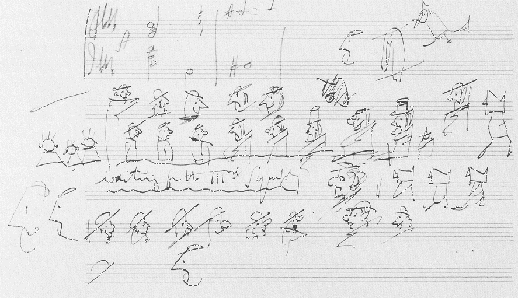WAITING ...
The last decade of Elgar's life was filled with concerts, festivals, horse-racing,
dogs, a home in the country - in fact, everything one might wish on someone in his
retirement. Except that we do not allow our composers to retire: we, and they, wait
expectantly for ... what, I wonder?
No news: garden going on: dogs well & very opinionated. I took Dick's besom down to the
river, dipped it in several times & washed the mud off the bottom step: when I looked round
there were three solemn folk sitting on the top step. They are awful(ly nice).
Letter to Carice, 8 May 1928
Many thanks for your letter: there is nothing to say about the mythical Symphony for
some time, - probably a long time, - possibly no time, - never.
Letter to Walter Legge, 5 August 1932
 |
| "Waiting for the IIIrd Symphony"
|
|
The author was now summoned to Marl Bank more frequently than ever. A great deal of
music was being written for this opera - the name was now altered to
The Spanish Lady (the name of one of the characters) - and he had written out
some of the numbers for violin and piano (the piano part consisting principally of his own
musical shorthand and quite undecipherable to any one but himself), notably a Spanish dance,
a bolero, a saraband, and a country dance. also numerous vocal portions which had to be
played on the violin while he played excitedly on the piano.
Then the playing would cease and he would tell the story of the opera with a wealth of
detail as to what was happening on the stage, pointing out a bar of the music that fitted
in with some particular situation. Seizing a piece of paper during one of these discussions
he hurriedly drew in pen and ink a rough sketch of the stage showing the position of the
church, the green, exits and entrances. He seemed to have it all in his head.
Then he would suddenly change the subject and go back to the piano and begin to play
portions of the third Symphony - growing excited over this,
just as he had been over the opera, and begging the author to get his violin and play this
or that phrase any number of times until he was tired. Then he would suddenly say: 'Enough
of this, let us go out in the car and take the dogs on the common. Marco is a lad and he
knows all about music.' Or, in another mood: 'Marco is a lad and he knows better than to
listen to music.'
W H Reed, January 1933
|